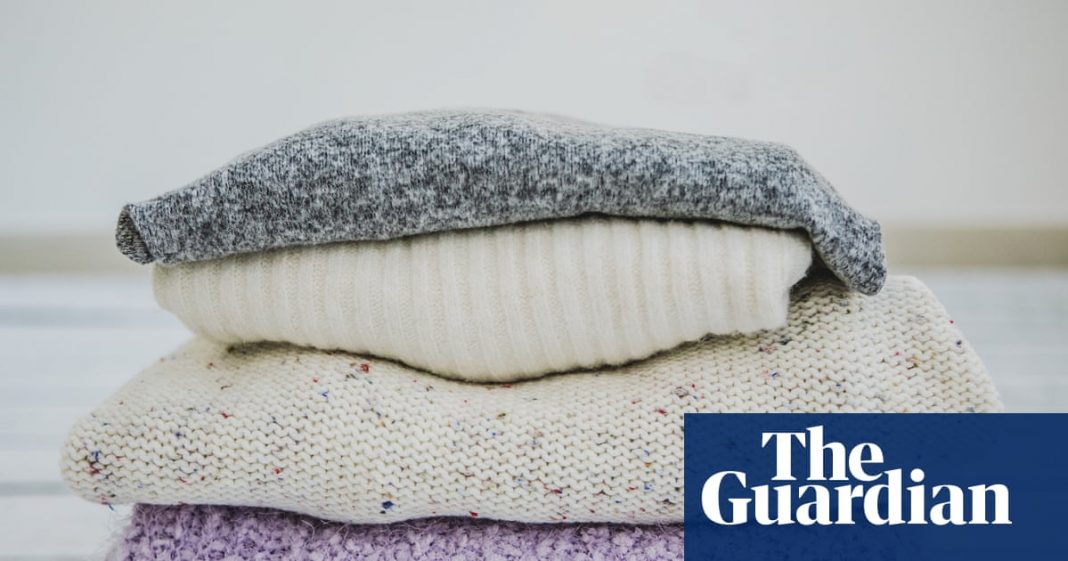Although I thought it wasn’t possible, this winter my love of knitwear hit new heights. The hardest working item in my wardrobe was a black, oversized fine wool T-shirt. I wore it over my workout gear, with blazers to meetings and layered beneath a thick cable knit when writing at home. I took to sleeping in a cashmere-silk blended singlet – if that sounds lush, it really is. I rarely left the house without an enormous woollen scarf which often doubled as an umbrella in Sydney’s rain.
As we come into warmer weather, it’s time to put these favourites away. From moths to mould, knitwear faces some perils while packed away, so I sought expert advice to ensure it can be retrieved in good condition next winter.
Only store clean knitwear
It is imperative that knitwear is cleaned thoroughly before storing it, says Prue Webb, co-founder of the Wardrobe Edit. Fibres can be damaged or discoloured by dirt, and any trace of oil or food stains will also attract moths.
How to wash your knits
Knitwear can be temperamental when washed, so be sure to follow the care instructions on the label.
For machine washable knitwear, “it’s pretty simple”, McIntyre Merino co-founder Ned Schofield Canapini says: “Machine wash on a cold wool cycle and always use a wool wash.”

For hand washing, fill a tub or sink with cold water and a mild detergent. Webb recommends the Wool and Delicate Wash from the Dirt Company. Then submerge the garment and gently move it around. “But quickly, only for a few minutes,” Webb says. “Do not soak.” Next rinse the garment under cold water (warm water is likely to cause shrinkage), then gently squeeze as much water out of the garment as possible, but be careful not to wring or twist it.
Dry garments flat
“If you hang the garment to dry, it will lengthen due to gravity,” says Schofield Canapini. Instead, start by laying knits flat on a clean, dry towel and gently rolling them up like a yoga mat, applying pressure as you go. This will get rid of enough moisture to stop garments dripping on the floor as they dry. Move the garments to a horizontal clothing rack and leave them to dry – out of direct sunlight and not too close to a heater.
Do some light maintenance
Before putting a knit away, it’s a good moment to give it a refresh by removing pills and tidying up loose yarns. Being mindful of jewellery, accessories and abrasive surfaces can help prevent these issues, but sometimes pulls and pills are unavoidable due to the softness and texture of knitwear. Luckily, both are easily fixed.
Webb says removing pills is a great way to bring a piece back to life. She suggests using an electric fabric shaver, which can be purchased for about $20. Then, lay the garment flat and “work in a circular motion with a light touch” to be sure you don’t damage it.
Loose or pulled threads can be hidden from sight by pushing the offending strand or loop back inside the garment. Do this with a large sewing needle or a crochet hook. If the pull has upset a whole row of stitches, with a little bit of care, these can be massaged back into place.
Repairing holes
If your knitwear has holes – whether from moths or other mishaps – there are two avenues to repair them.
One is tackling them yourself. For a small hole, Webb suggests closing it with a needle and thread. A more complicated way, that will better preserve the appearance of the knit, is darning. For this you’ll need a darning mushroom and the appropriate yarn. If you’re new to this process, watch some online tutorials or follow the advice provided here.
The other option is asking a professional. If the piece is particularly special and you would like it to look as good as new, seek out an alterations expert who does invisible mending. The work they do to restore knitwear is truly incredible, but it comes at a price.
Protecting against moths and moisture
When you’re ready to put your knitwear away, be mindful of two of the biggest threats: moths and humidity. Both can be avoided by storing knitwear in airtight storage bins or cotton garment bags (moths only really like the most expensive animal fibres).
If humidity is of concern, it’s best to avoid plastic garment bags and bins that are not aerated, as these can trap moisture. Be sure garments are completely dry before folding them (knitwear should never be stored hanging). Place them inside bags or boxes (don’t overstuff them) along with some cedar balls or silica bags. Both are “a great accompaniment to protect knits and absorb moisture,” says Webb.
The other way to safeguard against moths and humidity is by opening up your wardrobe every so often to let some light in and move things around. Moths and mould both thrive in the dark, so sunlight is an easy remedy. Movement – like shaking garments out and refolding them – prevents moths from settling and gives you the chance to air clothing, which will help alleviate dampness.
Getting rid of moths
If you’re concerned there are already moth larvae in your wardrobe, make sure you get rid of them before putting anything else into storage. One option for eradication is dry cleaning; another is brushing garments vigorously and leaving them in direct sunlight. Finally, you can heat treat them by putting them in the oven on the lowest heat (50C) but be mindful of synthetic blends or thread used in seams as these may melt. Finally, be sure to vacuum inside your wardrobe to get rid of any remaining larvae.


